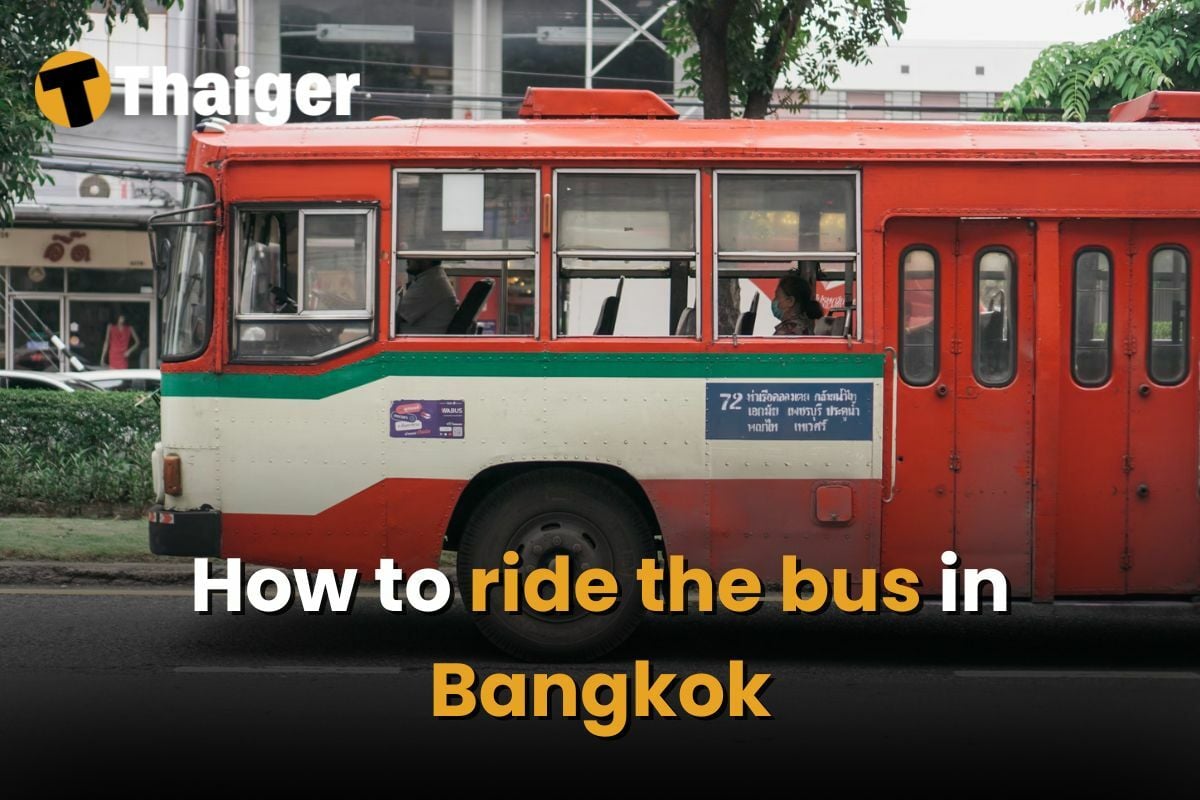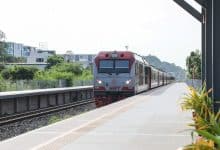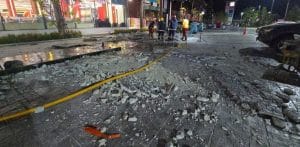How to ride a bus in Bangkok

Beyond Bangkok’s reliable BTS Skytrain and MRT subway systems, the city also offers an extensive bus network that continues to serve as a vital transportation option for residents and visitors. The Bangkok Metropolitan Administration (BMA) and Thai Smile Bus (TSB) operate a comprehensive fleet of buses that will help you get around Bangkok. Plus, it is a nice and cheaper alternative to getting around the capital.
However, for a lot of people, taking a bus in Bangkok might be daunting or alien to them so this should help get a clearer picture of how they operate.

How to get on the right bus and where to find them
Finding your way around Bangkok’s bus system begins with locating the nearest bus stop, which is distinguished by clear signage displaying available routes along major thoroughfares. While it may seem daunting at first, modern technology has considerably simplified the process. You can use Google Maps to identify nearby stops.
Alternatively, you can also opt for different bus route planning applications such as the BMTA’s ViaBus app, TSB’s TSB Go app, or other third-party route planner apps such as Moovit.

Understanding Bangkok’s bus numbering system is very straightforward. Here is a graph of the most used route in Bangkok, as there are plenty of routes to cover. You can either look at the boring graph or go to Google Maps or route planning apps to search for your destination. It should tell you all the specifics, including which bus to take, which routes they go on, and where to get off.
The best part is, depending on where you are going, the apps give you plenty of routes to choose from.
All the particular pieces of information are also available on BMA’s official website.
Key bus routes in Bangkok
Euro 2 bus is a bus that meets the Euro 2 emission standards for light commercial vehicles and passenger cars.
NGV bus is a bus that uses compressed natural gas (CNG) or liquefied natural gas (LNG) as fuel.
| Route Number | Start Point | End Point | Bus Type(s) |
| 2 | Samrong Depot | Pak Khlong Market | Regular |
| 3 | Northern Bus Terminal (Morchit 2) | Khlong San | Regular, Air-Con (Euro 2) |
| 4 | Khlong Toei Pier | Phasi Charoen Pier | Regular, Air-Con |
| 7ก | Borommaratchachonnani Bus Depot | Phahurat | Regular |
| 15 | The Mall Thapra | Sanam Luang | Regular, Air-Con (Euro 2) |
| 16 | Northern Bus Terminal (Morchit 2) | Surawong | Regular, Air-Con (Euro 2) |
| 18 | Tha It Market | Victory Monument | Regular |
| 20 | Phra Jun Fort | Din Daeng Pier | Regular, Air-Con |
| 21 | Wat Khu Sang | Chulalongkorn University | Regular, Air-Con (NGV) |
| 23 | Mega Bangna | Thewet | Regular |
| 24 | Prachaniwet | Victory Monument | Regular |
| 49 | Northern Bus Terminal (Morchit 2) | Hua Lamphong | Regular, Air-Con (Euro 2) |
| 114 | Nakhorn In | Lam Luk Ka Intersection | Regular, Air-Con (Euro 2) |
| 145 | Pak Nam | Bangkok Northern Bus Terminal | Regular, Air-Con (Euro 2) |
| 204 | Bangkok City Hall | Ratchawong Pier | Regular, Air-Con (Euro 2) |
| 522 | Rangsit | Victory Monument | Air-Con (Euro 2), Air-Con (NGV) |

How to stop a bus
Once your desired bus approaches, make a clear hand signal to indicate your intention to board. Riding buses in Bangkok requires you to maintain a fast-paced schedule, with brief stops that require prompt boarding – particularly during peak hours.
When you enter the conductor will approach to collect your fare. Communication with the conductor is straightforward, either state your destination or display it on Google Maps, then provide payment to receive your ticket.
As you near your stop, get up and proceed toward the exit doors. While signal buttons are available, drivers typically notice if a passenger wants to exit at the next stop. In Bangkok, the bus system features several types of buses catering to different needs and preferences. Here are the main types
Types of buses
In Bangkok, the system features several types of buses that take routes and are designed differently usually denoted by different colours and markings on the buses.
BMTA

Air-conditioned buses
These buses provide a comfortable ride with climate control, making them popular among commuters, especially during hot weather. Personally, while fan buses are generally fun when you are stuck in gridlock traffic during rush hour, you’d wish that you took an air-conditioned bus instead!
Colour codes: White-Blue, Yellow-Orange, Beige-Blue, NGV Blue (Natural Gas Vehicle)
Fare: The fare varies depending on the distance travelled, typically ranging from 12 to 25 Baht

TSB
Aside from BMTA’s offering, TSB also has a fleet of air-conditioned buses running around in Bangkok. For the most part, they operate on the same routes as BMTA buses do, but if you are unsure, you can always check in the route planner apps or on TSB’s website.
For the eco-conscious readers, you’d be happy to know that all of TSB’s buses are fully electric. This is part of TSB’s mission to reduce its carbon footprint in a city already known for its pollution. But beware these buses are quite quick! So be sure to find something to hold onto.

Another benefit of opting for TSB’s buses is their HOP card. If you frequently travel around Bangkok on buses, these cards will prove to be beneficial. Available for purchase on any TSB bus, the card offers its holders cashless travel and a daily max fare of 40 baht. Travelling around Bangkok has never been cheaper! Just remember to add credit on the TSB Go app before your travels.

Regular or fan buses
These are non-air-conditioned buses equipped with fans. They are generally less expensive than air-conditioned options.
Colour code: Primarily cream-red.
Fare: Fixed fares usually around 8 to 10 Baht for shorter trips.

Any unwritten rules?
There aren’t any unwritten rules when it comes to public transportation in Thailand, but common sense that we all need to remember. For example, remember to give up seats to the elderly, monks, pregnant ladies, or the disabled.
But for buses, especially with newer models with two doors, always remember to enter through the front door, and exit through the rear door. This helps the flow of passengers getting onto, and getting off the bus. During rush hour, make sure that you stand towards the back of the bus or away from any doors, in general, to make way for passengers entering and exiting the bus.
Also when paying in cash, we do advise that you carry around small change for the ticket collector just so that they aren’t burdened with any large bills, especially during peak hours.
Alternatives

If riding buses in Bangkok and all these services still do not cater to your needs you can approach a motorcycle stand and hail one of the bike taxis to your destination. Make sure to settle the cost of the journey with the driver before getting on to the bike.
In my experience, it has never cost over 150 baht, and the nearby distance should be around 50 to 60 baht.
However you choose to go around Bangkok, there are a lot of choices to use but buses might be something that you might want to give a try. The buses in Bangkok can even get you outside of Bangkok too at stations such as Mo Chit Station.
Latest Thailand News
Follow The Thaiger on Google News:


























